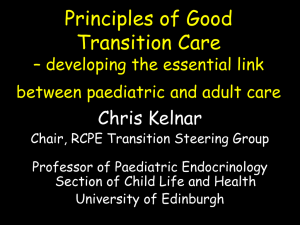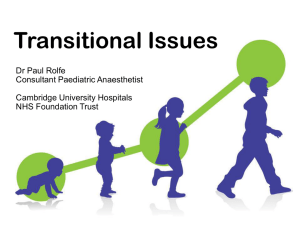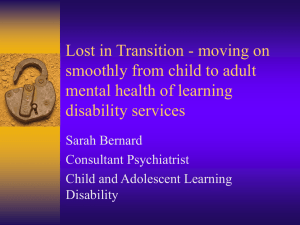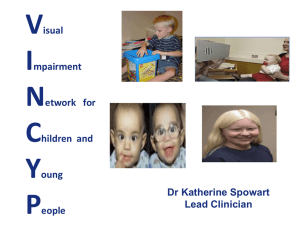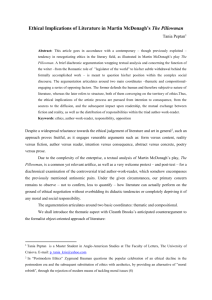Bridging the Gap Transitional Care for adolescents with chronic illness
advertisement
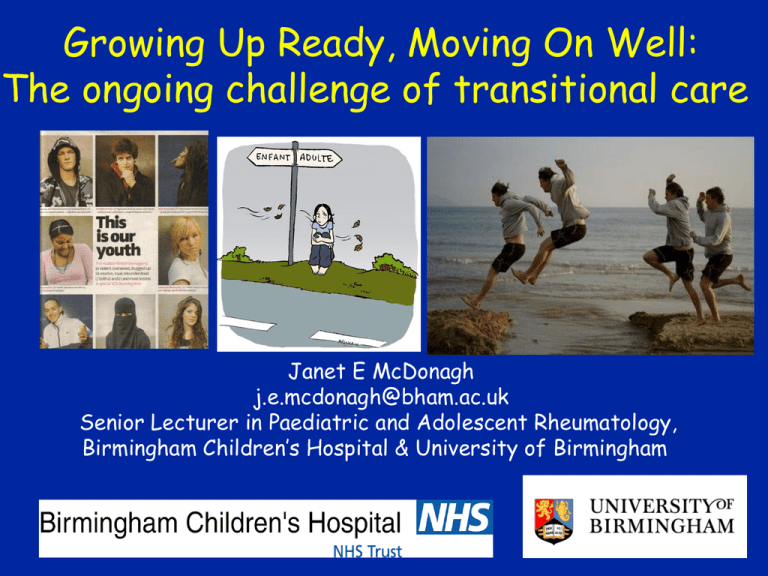
Growing Up Ready, Moving On Well: The ongoing challenge of transitional care Janet E McDonagh j.e.mcdonagh@bham.ac.uk Senior Lecturer in Paediatric and Adolescent Rheumatology, Birmingham Children’s Hospital & University of Birmingham Transitional care is Growing Up in the UK! www.dh.gov.uk www.transitioninfonetwork.org.uk “Transition - long the cause of complaint and unhappiness” • “Critical area” for service improvement as existing abrupt transfers are failing to meet young people’s needs Called for: • Discrete funding • Shift in focus towards the needs of the YP and away from “bureaucratic barriers” between paediatric and adult care NHS Children’s Review 2010 (UK) American Academy of Pediatrics “After nearly a decade of effort, widespread implementation of health transition supports as a basic standard of highquality care has NOT been realized” Pediatrics 2011 Are we asking the right question? How can we best manage transition? Vs It’s not about [arthritis] – it’s about living with it Shaw KL et al 2004 How best can we meet the needs of young people with chronic conditions at this stage of the life course? Allen D & Gregory J 2009. Data systems Transition coordinators Risk & protective factors Parents Peer influences Training for paediatric & adult professionals Healthcare systems & training structures Principles of Adolescent Medicine Psychosocial screening T Confidentiality Info and resources Longer appointments Understanding health condition Adherence Selfmanagement Managing of Health chronic condition disease Growing capacity for self-care Promoting autonomy (Kennedy A & Sawyer SM 2008) Transition Taster Outline • Evidence • Models and core components • Evaluation Evidence of Need Evidence of Need for Transitional Care E.g. • Survival • Disease outcomes • Morbidity • Developmental delay • Loss to follow-up • What young people and their families say Evidence of Need 5th UK Paediatric Diabetes Survey • 76% clinics had a transition “protocol” BUT • 21% transfer letter only Gosden C et al 2010 • NO transition planning process in at least 50% programmes Lam PY 2005; Robertson LR, 2006; McLaughlin SE 2008; Hilderson D 2009 Evidence of effectiveness of transitional care programmes Most commonly used strategies in successful programmes: • Patient education and skills training • Specific clinics – Combined paediatric and adult – Dedicated young adult clinics within adult services Potential: – Transition coordinators – Enhanced follow-up Crowley R et al 2011 (systematic review) Conditions for successful transition from perspective of young people • Meaning given to transition by patients • Expectations about transition and the adult centred care environment • Level of knowledge and skills • Transition planning • Environment Lugasi T et al 2011 (Theory Integrated Metasummary) Transition Taster Outline • Evidence • Models and core components • Evaluation Transitional Care Complex! – intervention, context, system Models • Sequential (reflects adolescent development) • Developmental (eg disability, cognitive impairment) • Professional-centred • Direct While A et al 2004 Transfer (minus transition!) • • • • • • Age out Drop out ( non-SHCN) Forced out Hang out ( SHCN) Move out ( non-SHCN) Transfer out Burke R et al 2008 *SHCN = special health care need Effective Models of Transition Systematic review of evidence of effectiveness of transitional care programmes (11-25 years) • Combined paediatric & adult clinic: 8 studies, 3 successful • Young adult clinic – 4 studies, 3 successful Crowley R et al 2011 Young Adult Team Approach eg physical disability • No more expensive than ad hoc services • Associated with better participation of young people in society (2.54 x) Bent N 2002 Core Components: People • • • • • • • Champions! A Coordinator Interested and capable adult team Primary health care Social care Education/vocational agencies Young People & their families Core Components: Process • • • • • • • Written Policy Knowledge and Skills* Framework Individualised young person centred planning process A young person friendly service Staff training Administrative support inc tracking mechanisms Evaluation and audit Self-management Skills and Transition Readiness n=954 12-19 year olds with chronic conditions Web-based questionnaire 48% of total variance in Tn Readiness explained • Perceived self-efficacious in skills for independent hospital visits • Perceived independence during consultations • Attitude towards transition • Discussion re transition Van Staa A et al 2011 Time Alone and Transition • Considered “Best practice and feasible” by YP with JIA, parents and health professionals Shaw KL et al, 2004 • Baseline predictor of improvement in HRQoL McDonagh JE et al 2007 • Determinant of attendance at 1 adult clinic appointment Reid GJ et al, 2004 • Only 30% (n= 311 paediatric) and 60% (n= 128 adult) young people seen alone by Dr (McDonagh 2011 in prep) Staff Training • Best Practice – but only feasible in a few UK hospitals: Professionals knowledgeable in transitional care Shaw KL et al, 2004 • Lack of training: Main barrier to delivery of transitional and/or adolescent health care McDonagh JE 2004, 2006; Dieppe C 2008 www.e-lfh.org.uk Transition Taster Outline • Evidence • Models and core components • Evaluation Transition Tools Condition specific • Rotterdam Transition Profile (CP) Donkervoort M et al 2008 • TRS Transition Readiness Survey (Liver Transplant) Fredericks EM et al 2010 Generic • TRAQ Transition Readiness Assessment Questionnaire Sawicki G et al, 2009 • Self-Management Skills Assessment Guide Williams T et al 2011 Shaw KL 2007 Transition Outcome Measures • • • • • Medical Psychological Social Educational Vocational Eg: Cystic fibrosis Post transfer • NO change in clinical status BUT Young people NOT in school/job 7.9% pre vs 31.5% post Dugueperoux I et al 2008 • JIA: Significant improvement in vocational readiness with transitional care McDonagh JE et al 2007 Social success, educational/vocational distress and chronic illness 24-32 year olds, n=13236 5% with chronic illness Similar odds: • Marriage • Having children • Living with parents • Romantic relationship quality Lower odds • Graduating college • Being employed Higher odds • Public assistance • Lower income Maslow GR et al 2011 Transition Taster Summary • Evidence • Models • Core components • Evaluation Data systems Transition coordinators Risk & protective factors Parents Peer influences Training for paediatric & adult professionals Healthcare systems & training structures Principles of Adolescent Medicine Psychosocial screening T Confidentiality Info and resources Longer appointments Understanding health condition Adherence Selfmanagement Managing of Health chronic condition disease Growing capacity for self-care Promoting autonomy (Kennedy A & Sawyer SM 2008) j.e.mcdonagh@bham.ac.uk

